eMDE – preventing lead poisoning, restoring the Bay, going green at school and the holiday table
THE LATEST FROM THE MARYLAND DEPARTMENT OF THE ENVIRONMENT
Leadership on lead poisoning prevention
Lead poisoning cases at lowest ever, 98 percent reduction since 1994
As Baltimore City Deputy Housing Commissioner Ken Strong left the press conference announcing the Hogan Administration’s plan to have all of Maryland’s children ages 1 and 2 tested for lead poisoning, he stopped MDE Secretary Ben Grumbles and Deputy Secretary Horacio Tablada in the parking lot.
“I just want to thank you and your staff for all of the great work you have done on the lead paint poisoning issue,” Strong said. “It has been an outstanding effort.”
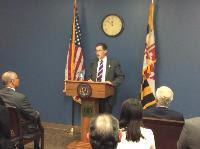
Secretary Ben Grumbles emphasized the importance of prevention in the fight to eradicate childhood lead poisoning
Indeed, it has been.
According to MDE’s annual Childhood Lead Registry, the 2014 report of which was released in July, the number of lead poisoning cases dropped to their lowest levels since Maryland’s lead law was passed in 1994 and the number of childhood lead poisoning cases has decreased 98 percent since the law’s enactment.
The number of cases statewide declined from 371 to 355 after rising slightly the year before. The City of Baltimore reported 194 cases, the fewest cases since records have been kept. More than 109,000 Maryland children were tested last year.
MDE’s lead paint program also has taken an aggressive posture toward enforcing a new law that expanded the universe of properties requiring testing from those built before 1950 to those built before 1978, when the use of lead paint was prohibited nationally. That change became effective January 1, 2015.
 The lead paint program has registered nearly 52,000 rental units that were built
The lead paint program has registered nearly 52,000 rental units that were built
between 1950 and 1978 and two other rounds of mailings have been sent to thousands of landlords. An MDE study four years ago found that properties built between 1950 and 1980 have an 80 percent likelihood of containing lead-based paint.
Duane Johnson, MDE’s Lead Poisoning Prevention and Environmental Justice Coordinator, said he thought the agency’s activities last month during Lead Poisoning Prevention Week were highly successful. Governor Larry Hogan issued a proclamation designating the week and noted that “there is no safe blood level and even very low levels of lead can affect children’s development, education and productivity throughout their lives.”
“We did a roundtable during that time with the departments of Health and Mental Hygiene, Housing and Community Development, Education, and Insurance,” Johnson said. “The reason for that was to emphasize that we all need to be on the same page about lead poisoning prevention efforts that have been successful.”
Johnson said he is working on two other initiatives to attack the lead paint poisoning problem, one focusing on the faith-based community in the Baltimore metropolitan area and another that will work collaboratively with university and college presidents within the state to increase outreach and get more students involved.
“The future looks really good for the children in our state being lead free,” Johnson said.
IN THE NEWS
WTOL-TV: Lake Erie could learn from Maryland and Delaware in cutting algae threat
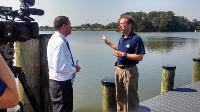 A television news crew from Toledo, Ohio, where an algae bloom caused a drinking water crisis, came to Maryland for lessons on how to combat water pollution
A television news crew from Toledo, Ohio, where an algae bloom caused a drinking water crisis, came to Maryland for lessons on how to combat water pollution
WTOL-TV’s Tim Miller reported on what Maryland is doing to clean up the Chesapeake Bay. He also reported on efforts underway in Delaware, and for the final installment of his three-part series he tied the information together for lessons that might be applied in Ohio and Lake Erie.

AIR, LAND, WATER – DID YOU KNOW?
Maryland pursues new tools, greater teamwork for faster, better restoration of Chesapeake Bay
Maryland is developing a nutrient trading policy to accelerate the restoration of the Chesapeake Bay while reducing costs to local governments and citizens and boosting private sector jobs, the Maryland Departments of the Environment and Agriculture announced today.
The Maryland Nutrient Trading Policy Statement details a roadmap for the development of cross-sector, water quality-based trading programs that use innovation, economies of scale and public-private partnerships to speed improvements to the Bay and local rivers and streams.
“The Chesapeake Bay is one of our most important, valuable and beloved resources and our cleanup efforts will not stop until the Bay is restored,” Governor Larry Hogan said. “These new tools, which make sense both economically and environmentally, are yet another example of our commitment to preserving our natural resources for generations to come.”
“Trading means upgrading and accelerating the cleanup through teamwork and innovation,” said Maryland Department of the Environment Secretary Ben Grumbles. “We are building upon, not replacing, regulatory tools with smarter, more effective strategies and broader partnerships.”
Hogan Administration announces new lead-testing plan for children
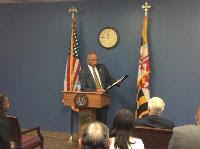 The Hogan administration announced the new Lead Testing Targeting Plan for Childhood Lead, which calls for all Maryland children to be tested at ages 1 and 2, no matter where they live. Previously, only children living in so-called “at risk” ZIP codes or who were enrolled in Medicaid had to be tested.
The Hogan administration announced the new Lead Testing Targeting Plan for Childhood Lead, which calls for all Maryland children to be tested at ages 1 and 2, no matter where they live. Previously, only children living in so-called “at risk” ZIP codes or who were enrolled in Medicaid had to be tested.
“We have made great progress in reducing lead exposure in Maryland over the past 20 years,” Governor Hogan said. “However, we need to test all children, not just a handful, in order to put an end to childhood lead poisoning in Maryland once and for all.”
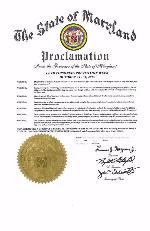 Lt. Governor Boyd Rutherford joined Deputy Secretary Dr. Howard Haft of the Department of Health and Mental Hygiene, as well as Secretary Ben Grumbles of the Department of the Environment, to announce the new plan at Total Health Care in Baltimore, one of Maryland’s largest minority-run, nonprofit, tax-exempt community health centers.
Lt. Governor Boyd Rutherford joined Deputy Secretary Dr. Howard Haft of the Department of Health and Mental Hygiene, as well as Secretary Ben Grumbles of the Department of the Environment, to announce the new plan at Total Health Care in Baltimore, one of Maryland’s largest minority-run, nonprofit, tax-exempt community health centers.
Governor Hogan proclaimed October 25-31 Lead Poisoning Prevention Week in Maryland.
Innovation on display, spirit of collaboration in the air at Department of the Environment’s Clean Water Business Expo
The 2015 Clean Water Business Expo brought businesses, local governments, developers and other stakeholders together to find cost-effective, innovative and efficient ways to reduce stormwater runoff and improve water quality in local watersheds and the Chesapeake Bay.
 “MDE’s Clean Water Business Expo is all about innovation and public-private sector collaboration – the winning combination to accelerate the restoration of the Chesapeake Bay and its local rivers and streams, while boosting Maryland’s economy,” said MDE Secretary Ben Grumbles.
“MDE’s Clean Water Business Expo is all about innovation and public-private sector collaboration – the winning combination to accelerate the restoration of the Chesapeake Bay and its local rivers and streams, while boosting Maryland’s economy,” said MDE Secretary Ben Grumbles.
Department of Environment improves regulatory climate for oyster growing operations
The Maryland Department of the Environment is changing water discharge regulations to remove an unnecessary requirement for businesses, including some aquaculture operations.
“This change advances one of the Hogan administration’s top priorities: removing unjustified regulations in order to boost Maryland’s business climate while maintaining important environmental safeguards,” said MDE Secretary Ben Grumbles. “We are changing Maryland for the better by rooting out unnecessary requirements and strengthening our commitment to aquaculture and other sectors that grow our economy and protect our environment.”
An ounce of Pollution Prevention . . .
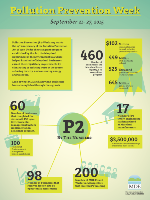 Check out this infographic (click on it for a larger version) and see what the Department of the Environment and Maryland businesses have accomplished through pollution prevention grants. Then click to learn how greening your business can save big money.
Check out this infographic (click on it for a larger version) and see what the Department of the Environment and Maryland businesses have accomplished through pollution prevention grants. Then click to learn how greening your business can save big money.
Environmental Science Student Award application opens, best science students in Maryland encouraged to apply for internship
The Department of the Environment will begin accepting applications Nov. 16 for the agency’s Environmental Science Student Award and Internship. The award recognizes high school seniors who have excelled in environmental science both inside and outside the classroom.
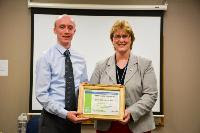
Josh Cocker, winner of last year’s award and internship, received a certificate of appreciation from MDE Deputy Secretary Mary Tung
Students who have demonstrated extraordinary leadership and participation in environmental projects in school or their community such as recycling drives, school beautification projects and stream or litter cleanups are encouraged to apply. The grand prize winner will receive a paid internship at the Department during the summer of 2016. The second-place winner will receive $500, and the the third-place winner will receive $250.
The deadline for nominations is May 15, 2016. Application forms and instructions are available on the Department’s website and may be submitted by email to Intern Coordinator Nadine Jackson-Bey at Nadine.Jackson-Bey@maryland.gov.
A Day to Serve
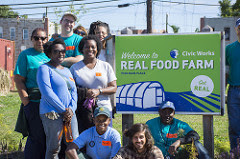 Department of the Environment employees celebrated Maryland’s Day to Serve Oct. 7 at Real Food Farm. Volunteers helped with the fall harvest, including mulching and weeding. Check out more photos of the day from our Flickr album.
Department of the Environment employees celebrated Maryland’s Day to Serve Oct. 7 at Real Food Farm. Volunteers helped with the fall harvest, including mulching and weeding. Check out more photos of the day from our Flickr album.
Get schooled: Going waste-free in the cafeteria and classroom
Reducing waste in your school can reduce your impact on the environment — and it can even save you money.
Click on this image for tips on how to reduce or eliminate waste during the school year.
And here are some lunch menus to get you started.
Seven tips for a Green Thanksgiving
Thanksgiving is quickly approaching and host and hostesses are starting to make guest and grocery lists, clip coupons and find new recipes to wow their guests. This year why not really impress your family and friends by making the holiday more environmentally friendly?
Shop locally
Try your local meat and farmer’s markets for pasture-raised turkeys, vegetables, and uniquely prepared side dishes and desserts. Local shops often stock a high percentage of local sourced foods, including fruits and veggies, which do not require long carbon-emission car and bus journeys and help reduce our global footprint.
Use candles
For an inexpensive, yet dramatic impression at your gathering use unscented candles to create a festive mood at your tabletop, mantel, or kitchen counter. Save some energy and money, while creating ambiance.
Decorate with nature
Skip the store-bought paper and plastic decorations and get inspired by the season. Use pumpkins, squash, Native American corn, pine cones, tree branches, green apples, and other natural items to make beautiful accents and centerpieces.
Can the grease
Not only is grease bad for your health, it’s terrible for your plumbing. Some tips: pour grease into an aluminum can and allow to cool; use a spatula to scrape any solid fats and food particles from the can into the trash; use a paper towel to dry wipe any remaining residue from the can into the trash.
Leave them with leftovers
Cut down on food waste by encouraging your guests to bring reusable carry home containers to help cut down on leftovers that would be thrown away.
Recycle your turkey carcass
Your turkey carcass and a gallon of water provide the perfect ingredients for a hearty soup stock. Toss in your carrot tops, celery leaves, and other leftover veggies for added flavor.
Start a compost pile
Your discarded veggie and fruit scraps provide the perfect ingredients for that long-awaited compost pile. Backyard composting is a straightforward process designed to speed up the decomposition of organic materials. If you put a pile of carbon-rich fall leaves, dead flowers from your garden, and your nitrogen-rich green kitchen scraps in a cardboard box in the back yard, they will decompose.
HAVE AN IDEA?
Email the Editor
We’re always looking for ways to make eMDE even better. Here’s a chance to tell us what you think. Have some thoughts on what we can do better or things you’d like to see more of? An idea for a specific story? We want to hear from you. Contact us!
MDE’s MISSION
Our mission is to protect and restore the quality of Maryland’s air, water, and land resources, while fostering smart growth, a thriving and sustainable economy and healthy communities.




